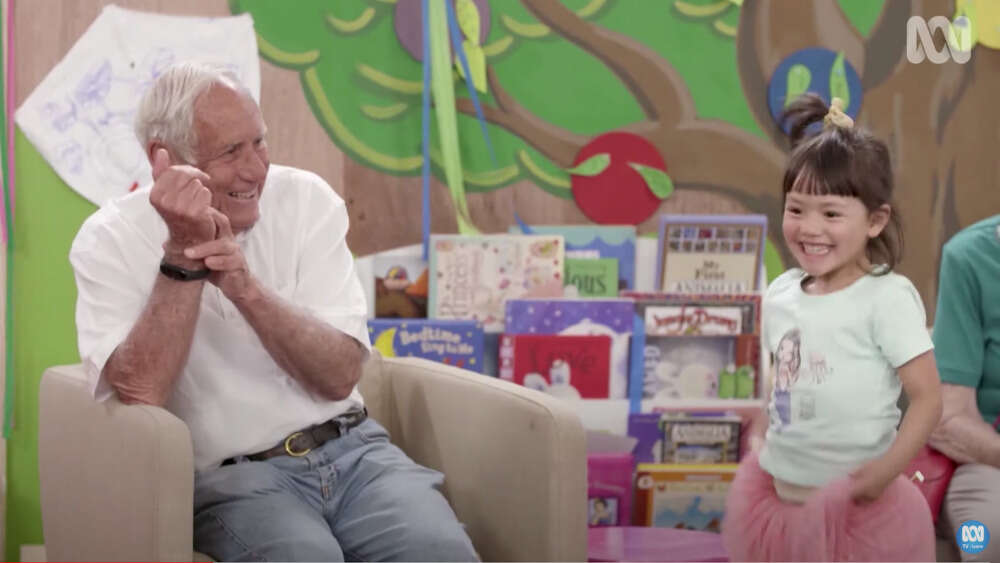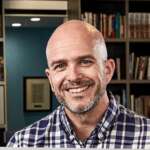If you’ve been watching Series Two of ABC TV’s Old People’s Home for 4 Year Olds, then you’ll know it was filmed at a church – St Nicholas’ Anglican Church, Coogee, in Sydney’s east. That’s where St Nics’ Christian Preschool is based.
No doubt you have been wondering how the church and its preschool became a star of the show. Well, Eternity caught up with rector Craig Segaert to ask. As it turns out, the TV program was just the tip of an iceberg, as the church is involved in a much larger intergenerational project based on the same concept as the show.
“When my wife Annie and I watched the first series [of Old People’s Home For 4 Year Olds] we were so moved by the change in [the older] people,” Segaert explains.
“The quote that struck us most was when one of the ladies said, ‘I got my life back,’ with a huge smile on her face.
Annie said, ‘Can’t we do something like that with our preschool?’ And I said, ‘Well, let’s try.'”
One Sunday not long after that, Annie was chatting with a visitor to their church. He turned out to be a world leader in the area of frailty in older people. He put the Segearts in touch with a researcher at Neuroscience Research Australia (NeuRA), associate professor Dr Ruth Peters.
Then, another congregation member connected them with the geriatrician on the ABC show, Stephanie Ward.
“So we got a group going with those two doctors and one of their PhD students, and we started planning to do our own intergenerational program, whereby older people in the community would come into our preschool and have that interaction,” Craig explains.
About the connections leading up to this collaboration between St Nics’ Preschool, NeuRA, UNSW Ageing Futures Institute and Sydney University, he adds: “God has worked in an amazing way to bring this about.”
The program – known as the Intergenerational Integration Initiative – aims to take a version of the show Old People’s Home for 4 Year Olds into the community. The aim is to collect scientific evidence on the benefits of intergenerational relationships, with the hope of rolling out the Intergenerational Integration Initiative far and wide.
“We are setting out to scientifically prove what has been anecdotally captured in the well-known ABC TV program,” says Dr Peters.
Using St Nics’ Preschool for a 10-week pilot program, older people from the community (including some members from St Nics’ church) will spend three hours a week doing activities with ten children at the preschool. Before and after the trial, researchers will examine the impact on frailty, mood and thinking skills in these adults, and on language and empathy in the preschoolers.
The hope is to make the concept sustainable and reproducible for communities across Australia. Following the pilot at Coogee, the results will be used to warrant expanding the program to six more preschools in 2022. The project is seeking $1 million to be able to fund this.
Although there are many other intergenerational programs in Australia and around the world, this one is unique, according to Dr Peters, because it “has been co-designed in a partnership between science and the community”.
“It is an exciting and fast-growing area with a lot of potential.” – Dr Ruth Peters
“In particular, this allows us to understand whether such a program could work in everyday life, as well as to collect data on the impacts it has on important outcomes such as frailty in the older adults and language development in the children,” she says.
“Though there have been other studies focused in aged care and with school-aged children, this study brings together older adults who live in the community [which 90 per cent of Australia’s retireees do] and preschoolers aged 3-5 years.
“This is the first study to combine the two age groups in this way, namely by connecting older community-dwelling adults with preschool children for a clinical trial like this in a local setting.
“It is an exciting and fast-growing area with a lot of potential.”
At the same time that St Nics’ began planning its own intergenerational experiment, the ABC began planning a second series of its Emmy award-winning program (produced by Endemol Shine Australia for the ABC). But this time the broadcaster wanted to film in a preschool, with older people who live independently being invited in.
“In other words, instead of taking preschoolers into an ‘old folks home’ [as in Series One], they wanted to bring old folks who are still living in the community into a preschool situation,” says Segaert.
It seemed like a match made in heaven. Through geriatrician Ward, the church and its preschool connected with the ABC, and it was agreed to film the program at St Nics’ late last year.
Three episodes of the Second Series of Old People’s Home for 4 Year Olds have so far aired since the six-episode series launched on April 6. The show brings together ten four-year-olds from St Nics’ and a group of Australians aged from their 70s to 90s.
The TV show – self-described as a “life-changing social experiment” – aims to demonstrate the positive benefits of these interactions for both generations involved. The mental and physical health of older participants is evaluated before, during and after their involvement with the preschoolers. But, as the show demonstrates, the children also greatly benefit from their actions with these older people.
“The kids [involved in the show, from St Nics’ Preschool] all built wonderful relationships with them … The children have continuously seen the older adults after the filming of the show. So they’ve invited them for Christmas and they do regular catch-ups on a monthly basis,” says director of St Nics’ Christian Preschool Lucena Neal.
“What we don’t want to happen is a 10-week program, which then just stops,” – Craig Segaert
She notes that these relationships – which also include the children’s whole families – are particularly important in an area of Sydney where, often, grandparents do not live close by.
“The majority of the children at St Nics’ – around 80 per cent – their grandparents live interstate or overseas and they don’t have a lot of contact with them … Having the presence of older people around is really important, I think, for early childhood development,” Neal adds.
“… I’d like [this intergenerational contact] to be a regular thing that we do on a weekly basis throughout the whole year … so it’s actually embedded in [what we do].”
Pastor Segaert is also keen to extend beyond the pilot for the Intergenerational Integration Initiative, which began today, April 20, at St Nics’ Preschool. In this way, he hopes to replicate the type of ongoing relationships which have resulted from both series of Old People’s Home for 4 Year Olds.
“One of the mothers of one of the children who was in the first TV series, they meet their ‘older person’ quite regularly. And she said to me that the little boy asked her the other day, ‘Is he my grandfather?’
“That’s the connection that is already working, and that’s what we’d like to be able to continue,” says Segaert.
“What we don’t want to happen is a 10-week program, which then just stops,” he adds.
“We want to try and grow out of that ministry … If we could get something going on a fairly regular basis that contributes to the wellbeing of people in our community, then that would be a positive outcome for the church.”
He describes this as a way to send “tentacles of blessing out into the community”, while noting that the program also offers “pre-evangelistic opportunities”.
“Having said that, when you have ongoing contact with people like that, then hopefully you have the opportunity to speak to them about faith, to invite them to church and other activities that we have going on,” Segaert explains.
“As well as being a blessing to the individuals, it might be an access way for them into church community, depending on the work of the Holy Spirit.”
Encouraging other churches to consider the possibility of intergenerational programs such as this one, Segaert says: “In the environment we’re in at the moment, which is becoming a little bit more hostile to Christianity, this could be another opening to reach a demographic which otherwise might not be reachable at the present time.”
For more information or to support the Intergenerational Integration Initiative visit NeuRA’s website.
Email This Story
Why not send this to a friend?



